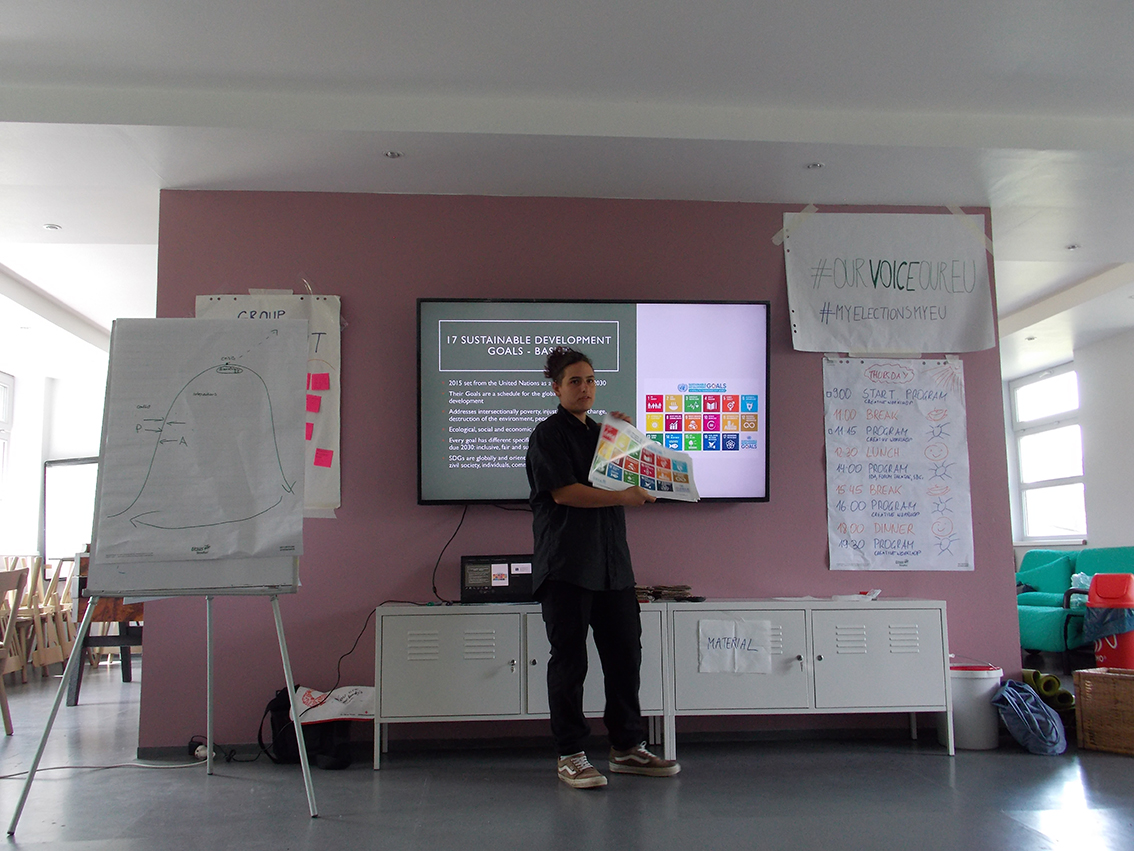Scenes of Change: Forum Theatre with SDGs
Download the methods
To download the methods, click here
Target group
No. of pax
Environment
Time needed
Materials
• Theoretical input (e.g. PowerPoint)
• SDGs cards or summaries
• A safer space agreement (see: Method Group Agreement)
Objective/aim
The aim of the activity is to empower participants to explore social and global issues using Forum Theatre methods. By embodying conflicts and experimenting with interventions, they learn to imagine and rehearse alternative solutions. It encourages critical thinking, empathy, collective problem-solving, and the development of alternative solutions to real-life challenges represented in theatrical scenes.
Step by step instructions
Step 1
Theoretical Input
15 min
• Brief introduction to the Sustainable Development Goals (SDGs): What are they and why are they relevant?
• Example: SDG 16 (Peace, Justice and Strong Institutions): Indigenous communities in Colombia and peace dialogues.
• Explain that participants will work with an SDG that resonates with them, creating short scenes using Forum Theatre methods.
• Visual support: draw or show the “Forum Theatre curve” (e.g., conflict escalation and transformation).
Step 2
Warm up exercise
5 min
• Walk freely around the room
• Imagine a character that is not yourself (pause and raise hands once imagined).
• Choose an inner number (1 = insecure, 10 = very secure) and an outer number (1 = visibly insecure, 10 = completely confident).
• Interact with others as this character (greet, introduce yourself and show your ‘habitus’).
• Shake off the character at the end.
Step 3
Create scenes
25 min
Form 3 groups that create a short scene with no happy ending. The groups have 20 minutes time for a 1-2min scene.
Choose one clear theme with a conflict, everybody embodies a character in the situation.
Choose one SDG, afterwards the groups get three words to create a scene around.
• SDG 1 No poverty: SLandlord, capitalism, single father
• SDG 2 Zero hunger: Supermarket, food waste, asylum seeker
• SDG 3 Good health and well-being: Factory, ambulance, worker
• SDG 4 Quality education: Private school, socioeconomic background, student
• SDG 5 Gender equality: News channel, sexism, non-binary person
• SDG 6 Clean water and sanitation: Contamination, privatisation of water, girl
• SDG 7 Affordable and clean energy: Gas, inflation, dog
• SDG 8 Decent work and economic growth: Textile factory, riot, woman leading the department
• SDG 9 Industry, innovation and infrastructure: Investment, traffic, nurse
• SDG 10 Reduced inequalities: Bureaucracy, deportation, hiding person
• SDG 11 Sustainable cities and communities: Smog, corruption, mayor
• SDG 12 Responsible consumption and production: Smartphone producer, increased consumption, teenagers working in a mine
• SDG 13 Climate action: Government, coal energy, family
• SDG 14 Life below water: Trawling nets, species extinction, fisher
• SDG 15 Life on land: Forest, biodiversity, Indigenous community
• SDG 16 Peace, justice and strong institutions: Group of rebels, dictator, siblings fleeing
• SDG 17 Partnerships for the goals: Nuclear bomb, economic sanctions, president
Step 4
Perform and intervene
1-5 h
• One group at a time presents their scene.
• Scenes are repeated; now the audience can stop the performance and intervene either by:
a) Stepping in to replace a character, or
b) Asking questions to the performers before the scene continues.
• Rule: You cannot take the oppressor’s highest power position to solve the conflict.
• Only one intervention per group per round; on-stage participants stay in character, those stepping in try to propose improvements or alternatives.
• Joker moderation: countdown “3, 2, 1, action”, then ask: What feels wrong on stage? What is each character’s secret wish? Discuss with the audience and actors how the intervention felt and what changed.
Step 5
Debrief
15 min
Take time to properly debrief this experience in smaller groups or a plenary depending on group size.
Tips for the trainer
• Familiarise yourself with the Theatre of the Oppressed literature; safe facilitation of interventions is essential.
• With less time, focus on the theoretical input and one or two warm-ups, then allow each group to create shorter or combined scenes. Limit interventions to one per group if needed.
Alternative
You can carry out this activity in different ways according to the participants’ experience level, group size, and available time. For example, theoretical input can be presented via video or digital slides instead of a flipchart. The reflection at the end can be done as a group discussion instead of individual written work.
Comment
Source
This setting was invented and described for a Master Thesis by a participant, Ida Bürgermeister:
• Bürgermeister, I. (2025). Scenes of Change – An Action Research on the Application of Forum Theatre in ESD and Green Pedagogy. Hochschule für Agrar- und Umweltpädagogik
Important literature:
• United Nations. (2015). Transforming our World: The 2030 Agenda for Sustainable Development [Department of Economic and Social Affairs].
https://sdgs.un.org/publications/transforming-our-world-2030-agenda-sustainable-development-17981
• Freire, P. (1970). Pedagogy of the Oppressed. https://www.fachportal-paedagogik.de/literatur/vollanzeige.html?FId=3073910
• Boal, A. (2013). Übungen und Spiele für Schauspieler und Nicht-Schauspieler. Suhrkamp Verlag.


